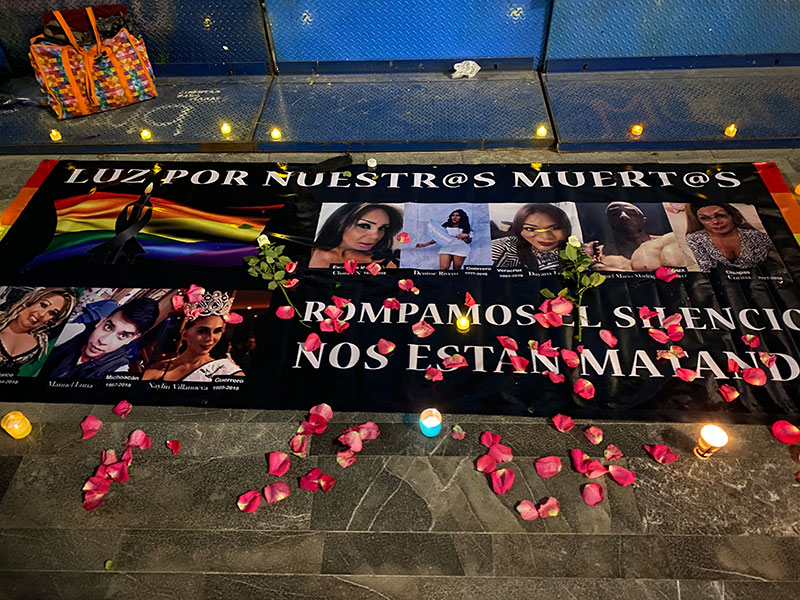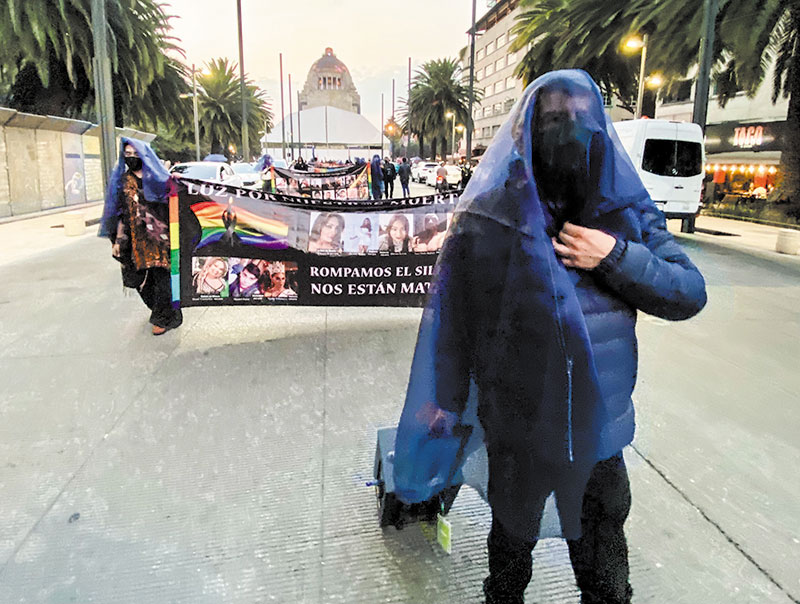Catwalk participants, above,
Party commemorates 1901 event that saw 41 LGBTQ men arrested
JESUS CHAIREZ | Contributing Writer
ChairezStudio@gmail.com
MÉXICO CITY — On Saturday, Nov. 20, a group consisting mostly of gay men and transexuals came together to commemorate the day 120 years ago that 41 gay men attending a private gay dance party on Nov. 17, 1901, in Mexico City were arrested and taken prisoners by police.
That event — which happened 68 years before the Stonewall Riots in New York City, is known as the Baile de los 41 (the Dance of the 41).
Although the Dance of the 41 and the Stonewall Riots happened decades apart and in different cities in different countries, both mark seminal moments in the ongoing battle for LGBTQ civil rights and equality.
Last month’s event in Mexico City was held at the home of gay activist and a local “nocturnal personality” Rafael Cruz Báez, known as Casa de Biarritz 13. The title and theme of the party was “41 Fetiches (41 Fetishes),” and everyone was encouraged to wear their favorite fetish gear. Many people did just that, resulting in a decidedly campy evening, surely reminiscent of that event 120 years ago.
Cruz’s home fits in well in with the other homes built in the early 20th century in the Centro Historico neighborhood, known in 1901 as a haven for the rich who left the city’s center. His home is just one subway stop away from Mexico City’s gayborhood, La Zona Rosa, and one block from where male prostitutes stand on the street to make a living. Arriving for the party by subway was entertaining since you could tell which riders were also headed there by their festive outfits — almost sort of like going to the Pride parade each June.

Phavel Tovilla Moya, left and Rafael Cruz Báe, right. Photos courtesy Eriko Stark
Although people usually arrive late for parties in Mexico City, when this party’s start time of 9 p.m. rolled around, there was already a line at the door. Although Cruz had encouraged everyone to purchase tickets online beforehand, there were still many people paying 200 pesos ($9 USD) at the door.
Guests entering the front door found themselves in a large living room with a fireplace and, as is common in older homes in Mexico City, very high ceilings. There were no furnishings in the room since Cruz had removed them long ago to make room for the parties for which he is known. The first thing arriving guests saw, though, was an elaborate winding staircase which provided the runway for the fetish catwalk taking place at midnight.
The festive party was full of men dressed in leather, either alone or accompanied by their leather-masked, dog-faced slaves. There was also plenty of lace and Levis and men in drag. There were even a couple of men who wore only cockrings.
Trans icon Terry Holiday-photo-by-Eriko-Stark
The house and patio were packed, and although participants arrived with facemasks to protect against COVID-19, all masks came off once them got inside. Cruz did take COVID-19 safety precautions into consideration, keeping the doors and windows open for ventilation. But since everyone was vaccinated, there seemed to be very little, if any, concern of anyone catching COVID.
The most important feature of the evening was the show, a catwalk that began at midnight. For more than an hour beautiful trans women, leather men, cowboys and several men wearing almost nothing to show off their endowments strutted their stuff down the spiral staircase in their best fetish attire.
The first people down the stairs were the host, Cruz wearing his basic black, and cohost, Phavel Tovilla Moya who was wearing a gown he created himself. Making her grand entrance next was queen of the evening, Mexico City’s trans icon Terry Holiday. Then came gay activists Luis Melo and Arturo Ricco, who were wearing actual props used in the movie El Baile de los 41, currently streaming on Netflix. The movie won an Ariel Award, Mexican cinema’s version of an Oscar, for Best Costume Design in 2021.
Melo wore not only a woman’s dress but also a large fake mustache, harkening back to the political cartoons José Guadalupe Posada drew back in 1901 at the time of the Dance of the 41. Ricco was wearing a replica of the uniform worn at the time by personal guards of then-president and dictator Porfirio Díaz.
 Before the catwalk show began, Cruz explained the history of the Dance of the 41 and its place in LGBTQ history. According to legend, there were 42 gay men arrested that night at the dance, but one — supposedly the son-in-law of Porfirio Díaz — was released, making the number 41. There were other men there wearing suits who escaped arrest by claiming they did not realize their dance partners were men in drag. And of course, those with means and money were able to buy their way out of trouble, proving that, in some ways, the Mexican judicial system has not changed much.
Before the catwalk show began, Cruz explained the history of the Dance of the 41 and its place in LGBTQ history. According to legend, there were 42 gay men arrested that night at the dance, but one — supposedly the son-in-law of Porfirio Díaz — was released, making the number 41. There were other men there wearing suits who escaped arrest by claiming they did not realize their dance partners were men in drag. And of course, those with means and money were able to buy their way out of trouble, proving that, in some ways, the Mexican judicial system has not changed much.
 Those arrested that night in 1901 were never taken before a judge for due process. Instead, they were taken to the police station where they were made to sweep the streets, still wearing their party dresses. Later, they were put on a train and taken to the state of Veracruz , then on to the Yucatan, “where they would do forced labor as a function of the crusade against the few Mayans who still resisted,” according to Dr. Michael K. Schuessler, professor of the Humanities Department of the Universidad Autónoma Metropolitana, in his thorough and informative essay, El “Baile de las 41”: Leyenda urbana y punto de partida de la homocultura Mexicana (The Dance of the 41 – Urban legend and starting point of the Mexican homoculture).
Those arrested that night in 1901 were never taken before a judge for due process. Instead, they were taken to the police station where they were made to sweep the streets, still wearing their party dresses. Later, they were put on a train and taken to the state of Veracruz , then on to the Yucatan, “where they would do forced labor as a function of the crusade against the few Mayans who still resisted,” according to Dr. Michael K. Schuessler, professor of the Humanities Department of the Universidad Autónoma Metropolitana, in his thorough and informative essay, El “Baile de las 41”: Leyenda urbana y punto de partida de la homocultura Mexicana (The Dance of the 41 – Urban legend and starting point of the Mexican homoculture).
In a conversation before his party in November, Cruz noted that the award-winning film on Netflix includes a number of historical inaccuracies. Still, he said, he is willing to forgive those flaws because the film is shining new light and bringing global awareness to an important but overlooked chapter in the history not just of Mexico’s LGBTQ community, but the LGBTQ around the world.
Jesus Chairez is a former Dallas resident who was producer and host of North Texas’ first bilingual LGBT Latino radio show, Sin Fronteras, on KNON 89.3 FM; from July 1993 to July 2005. His writing is published in the book, Queer Brown Voices: A collective of Personal Narratives of Latina/o Activism. Chairez now lives in México City where he works freelance writer. Contact him at Facebook.com/JesusChairez.
………………..
Shining a light to honor the dead

200 gather for Mexico City’s 3rd annual Light for Our Dead
MÉXICO CITY — On Saturday evening, Nov. 27, Mexico City’s LGBTQ community came together for the city’s third annual Luz por Nuestr@s Muert@s (Light for Our Dead) march to honor the LGBTQ lives lost to violence and poor health care. Some 200 participated in the march beginning at the Monument to the Revolution located in Mexico City’s center.
The solemn procession left the Monument to the Revolution and made its way half a mile to Alameda Park, stopping at the Benito Juárez Hemicycle.
I couldn’t help but get emotional viewing the banners showcasing the many faces of young LGBTQ lives lost to hate. Walking alongside the young men carrying the banners, all black-veiled activists, gave me some solace. I knew that if anything should happen to me, I too would not be forgotten.
The procession stopped traffic on Mexico City’s grand avenue, Paseo de la Reforma. It was gratifying to see that people did not honk their horns to try to hurry the marchers along; they stayed quiet in respect so as to remember and grieve in peace.
Information provided at the event indicated that every day the LGBTQ community finds out about some new assault or murder in Mexico’s community. There is even a new “fascist group of pseudo feminists offering 1,000 pesos ($45 USD) for each trans woman who is disfigured with acid.”
Disgusting, but real.
When the procession made it to the Benito Juárez monument speeches were made and all banners were laid on the ground and then surrounded by candles and rose petals. It was great to see this is an annual event bringing attention to lives lost.
— Jesus Chairez

















Muchas gracias por las dos notas querido Jesús Chairez especialmente la de Luz por Nuestr@s Muert@s